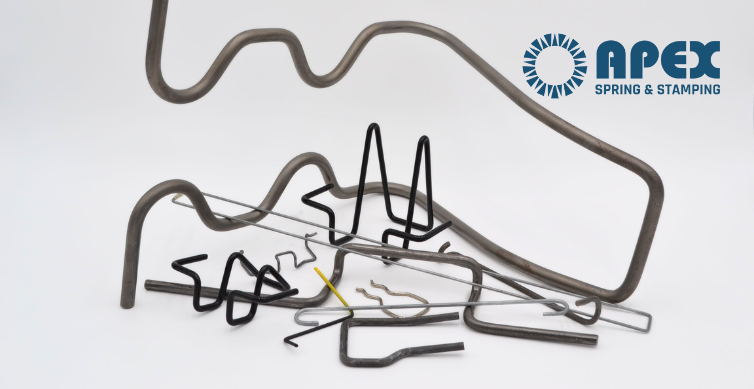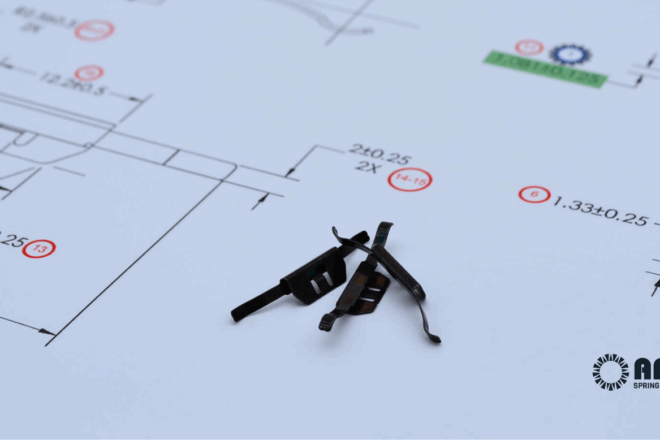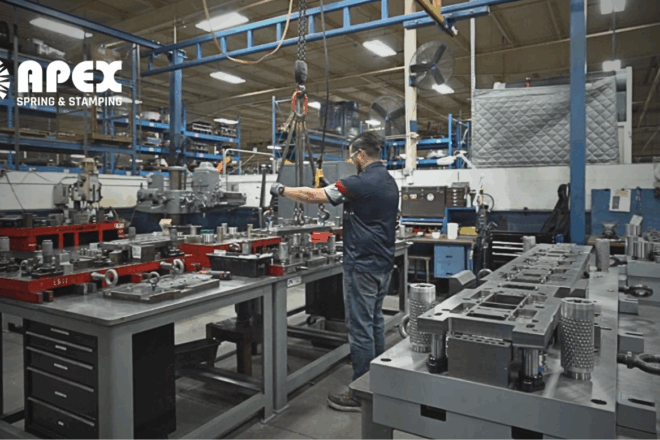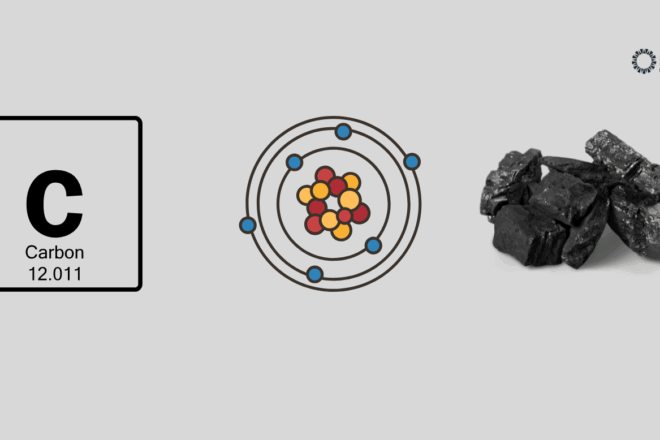The use of precision wire forms includes a wide spectrum of applications that depend on the performance to ensure the safety, efficiency, durability, and more. Wire forms include everyday items, such as wire hangers, paper clips, springs, musical instruments, pins, pegs, and different forms of fasteners. But wire forms are used in many industrial applications as well.
Manufacturing wire forms uses a variety of production methods that apply force to change the shape, form, dimensions, and appearance of simple wire. The various techniques include bending, swaging, piercing, chamfering, and cutting wire such that it takes a desired form to meet the requirements of an application or procedure. Different methods produce shapes, designs, forms, and configurations that change common wire into useful parts and components.
While the same methods apply, wire forms can really be divided into two groups. First for common everyday use and second, for industrial use. The primary difference is in the required amount of strength and stability. Wire forms for household and office have less stringent requirements and often use less durable types of wire. Industrial wire forms are designed for demanding applications and necessitate the use of highly durable materials that can withstand constant and stressful conditions.
Why Wire Forms are Useful
Available in an endless number of shapes, forms, configurations, and designs for industrial and consumer products, the wire forms simple construction makes it possible to create a product for many types of process, application, or criteria. The many varieties of wire forming equipment can be adapted to produce any type of wire form, regardless of how unique, complex, or unusual the form may be. The following describe many aspects of what makes wire forms a useful option in design, engineering, and manufacturing.
- Materials
Because wire forms are produced using a wide selection of materials that are highly durable and adaptable it makes it a versatile and viable option for many applications. - Prototyping
The nature of wire forming makes it possible to take a design and produce a rendering of the design for examination, inspection, and experimentation. Wire form engineers can take drawings or descriptions and transform them into a viable wire form prototype. - Safety
One of the aspects of wire forms that tends to be overlooked is their capacity to keep the powerful components of equipment safe by securely holding them together and being exceptionally durable. In some cases, wire forms are the first line of protection for workers when operating heavy machinery. - Complex Assemblies
Wire forms are widely used to join complex and intricate products that have unusual design constraints. The adaptability of wire forms makes it possible to produce the perfect wire form for a product, regardless of its intricacies. - Stability and Reliability
The connective strength of wire forms makes it possible to securely hold other components in place to guarantee equipment stability. The versatility of wire forms makes them an essential part of the efficient organization of parts and components. - Tolerances
Wire forms have the ability to meet the requirements of the tightest tolerances. They can be designed with the most stringent details that are necessary to hold components in place and provide safety and stability. The materials used to produce wire forms ensures the longevity and durability of wire form products. - Customization
As mentioned, wire forms can be designed and manufactured in an endless number of shapes, forms, configurations, and designs. This allows for great customization to configurable the materials and adapt for many sets of requirements.
Common Types of Wire Forms
It’s not enough to say that wire forms come in many shapes and sizes. We’ve already established they are versatile. So, what are some of the most common types of wire forms?
- Springs
Springs, while a product of their own, are technically a wire form. They are commonly found in a wide variety of applications. The design of the spring will depend on its application. Material is also chosen based on application and design. To manufacture a spring, the material is shaped and wound to specific specs for its application. Springs are carefully engineered and monitored to ensure the proper performance. - Clips
Clips are wire forms that include small paper clips, binder clips, and spring clips for household use with larger clips or clamps being used for industrial applications. They are made from different materials using spring tempered wire. The type of wire used for clips varies with the application. Small diameter wires are used for household clips while large diameter hardened steels are used for industrial clips. - Pins
Cotter pins are a wire form that is a straight pin with a loop at the top and curves down the side of the pin. The two sides (straight and curved) are tightly placed together for connecting two items. Specific material is used to create cotter pins to make them exceptionally strong and durable. They can be inserted into a predrilled hole, placed over a shaft, or used as a means of locking an opening. Cotter pins come in a wide variety of sizes and wire diameters, which makes them applicable for household and industrial use. - Wire Handles
Wire handles are a common type of wire form, which are used for carrying buckets, door pulls, D rings, and more. There are several varieties of wire handles being made in different forms to provide a pleasing appearance or serve a different application. The forms of wire handles vary from lightweight to very thick with exceptional durability. - Hooks
Wire form hooks are one of the most common wire forms and are produced in different designs from small hooks for commercial use to large industrial hooks. They are made of high strength durable steel and stainless-steel wire. Hooks for coats, keys, and towels are common household uses while industrial uses include heavy duty hooks for carrying tools, parts, and machinery.
Applications for Wire Forms
Moving on from specifics about design and manufacturing. Let’s consider some of the most common applications for using a wire form. They can be used in anything from light fixtures, furniture, automobiles, appliances, aircraft, industrial applications, and more. When most people think of wire forms, they normally envision springs, clothes hangers, and clips. But, these popular wire forms are a small portion of the many other uses for wire forms. The following are some of the most common applications for wire forms.
- Automotive
As with many products, wire forms for the auto industry are an essential part of the structure and mechanical functions of vehicles. They include retaining clips, springs, connectors, airbags, and seat and seat belt assemblies. The wide use of wire forms in automobile assembly is due to their ability to handle high stress and resistance to fatigue regardless of temperature fluctuations and vibrations. In addition, the flexibility and adaptability is ideal for vehicle manufacturing since they can be customized to fit into tight and difficult to access spaces. - Medical and Healthcare
The regulations and specifications of the medical and healthcare industries requires that every device be of the highest quality and highest standards. Wire forms are a necessary part of meeting the demands and criteria the industry has to follow. The most essential types are surgical tools that can be sterilized and meet hygienic requirements. Another critical use is in orthodontics where wire forms are used to align crooked teeth. For all aspects of the medical and healthcare industry, wire forms are manufactured using biocompatible metals that adhere to Federal Drug Administration (FDA) regulations. - Electronics
An obvious use of wire forms is in the electronics industry where they are used as clips, contacts, springs, and connectors. In many cases, wire forms for electronics have to be customized to meet the necessary precision and small size of components for servers and computers. Much like the specialized parts for the auto industry, wire forms for electronics are adjusted, shaped, and formed to fit into tight hard to access spaces. - Aerospace
The first thought of any aeronautical engineer that designs aircraft is the weight and size of components, which are critical design factors. It is for this reason that wire forms are ideal for the aerospace industry since they can fit into any space and can be engineered for any application. In addition, wire forms are able to withstand the stress and conditions of aircraft operation and have the strength, durability, and required weight. Wire forms are part of landing gear mechanisms, fasteners, and spring-loaded parts. As innovations are added to aircraft, wire forms are engineered, designed, and customized to meet changing standards and applications. - Construction
The main use of wire forms in construction is as reinforcements for concrete forms to help structural components maintain their integrity. This aspect of the use of wire forms is due to the stress placed on concrete forms and ensures their longevity. Aside from reinforcing concrete forms, wire forms in construction are used as anchors to hold non-structural components and connectors. The properties of wire forms are the main reason for their use in construction since they have exceptional durability, load bearing capacity, and a long useful life. - Military
Military operations require the use of multiple tools to ensure efficiency, safety, and protection. Wire forms play a vital role by providing fasteners and connectors that are secure and durable. The common types of wire forms that are for military use include clips, fasteners, springs, and connectors, which are included in weaponry and communications gear. Wire forms can also be made with material that can endure the harsh and hazardous conditions of military operations. Produced in accordance with military standards, known as “MIL-STD”, wire forms for the military are made to be unfailing and long lasting.
The APEX Spring and Stamping Difference
Apex takes great care in manufacturing a wide variety of wire form products. Designed and manufactured fully customized for your application, you can trust in our knowledge and experience to produce a product of the highest quality. And, we work hard to build a solid relationship along the way. Our team is ready to dive in and come alongside you and your team for your next project. Contact us today!
| Contact Us | Request A Quote |




